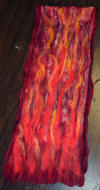Nuno Felted Scarves
“Nuno” is the Japanese word for fabric. Nuno felt is a term that describes wool bonded to fabric. This is also referred to as “laminated” felt. The resulting fabric is lightweight with incredible drape and flexibility. The possibilities for combining transparency, wonderful texture and layering of luxury fibers creates fabric that is only limited by your imagination.
This is an “all day” workshop where we will create a Nuno felted fabric by felting merino fibers onto a fine silk gauze base.
 |  |
Cost of class: $50.00 plus a $4.00 supply fee for your fabric
Skills you will need to bring to class: Preferably you will have completed the “Fabulous ‘Light as a Feather’ Felted Scarf class, because you will bring techniques that you learn from that class into this one.
Supplies to bring
1. 3 ounces of Merino top or roving. Must NOT be superwash! Can be natural or dyed.
2. Embellishments: fibers or yarns of your choosing such as silk, mohair, tencel, alpaca, flash, etc. - bring your odds and ends!
3. Bring your felting kit: bubble mat, wet out cloth and plastic. I also have these for sale in the shop if you need replacements or extras
4. 2 plastic squirt bottles (I will have extras to share as well)
5. plastic dish tub for rinsing your cloth
6. 2 panty hose legs
7. 2 thick thirsty towels
8. measuring tape or yardstick, marker
9. bring your energy and your boogie shoes!
CLASS TOPICS
REVIEW ON FELTING FIBERS
1. Selecting base fibers for nuno migration
2. Notes on dyeing both fabric and fibers
NUNO DESIGN
1. Single sided Nuno, double sided Nuno
2. Planning for open spaces
3. Fabric - to dye or not? Design decisions...
4. Texture effects of felted areas versus open spaces
5. Making a template
LAYOUT
1. Edge layouts and treatments
2. Drafting
3. Directionality in layouts
4. Fringe considerations
5. When you need to veil your embellishments
6. The importance of water temperature and why
7. Proper wet-out technique
FELTING
1. Rolling up, mat rolling, wax on/wax off, grasshopper!
2. How to create migration (first we migrate, then we felt!)
3. How to test for migration
4. Felting test
5. Managing edges, and spot felting
6. Fulling
FINISHING TECHNIQUES